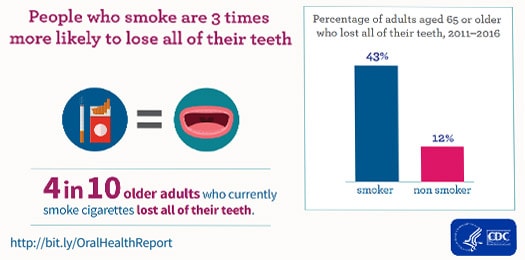Overview
- Oral health is essential to general health and well-being.
- Oral disease can cause pain and infections that may lead to problems with eating, speaking, and learning. It can also affect social interaction and employment potential.1
- The three oral conditions that most affect overall health and quality of life are cavities, severe gum disease, and severe tooth loss.2
- By age 8, over half of children (52%) have had a cavity in their primary (baby) teeth.3
- Low-income children are twice as likely to have cavities as higher-income children.3
- 1 in 4 adults aged 20 to 64 currently has cavities.3
- Drinking fluoridated water and getting dental sealants (in childhood) prevent cavities and save money by avoiding expensive dental care.4, 5
- Tobacco use and diabetes are two risk factors for gum disease.6, 7
- On average, 34 million school hours are lost each year because of unplanned (emergency) dental care, and over $45 billion in US productivity is lost each year due to untreated dental disease.8
- Medical-dental integration between oral health and chronic disease prevention programs benefits patients and saves money.9
Featured Infographics
- U.S. Department of Health and Human Services. Oral Health in America: A Report of the Surgeon General. Rockville, MD: U.S. Department of Health and Human Services, National Institute of Dental and Craniofacial Research, National Institutes of Health, 2000.
- World Health Organization. (2020, March 20). Oral Health. Retrieved April 3, 2020 from https://www.who.int/news-room/fact-sheets/detail/oral-healthexternal icon
- Centers for Disease Control and Prevention. Oral Health Surveillance Report: Trends in Dental Caries and Sealants, Tooth Retention, and Edentulism, United States, 1999–2004 to 2011–2016. Atlanta, GA: Centers for Disease Control and Prevention, US Dept of Health and Human Services; 2019. https://www.cdc.gov/oralhealth/publications/OHSR-2019-index.html
- Community Preventive Services Task Force. Oral Health: Preventing Dental Caries, School-based Dental Sealant Delivery Programs. Atlanta, GA: US Department of Health and Human Services, Community Preventive Services Task Force; 2016. https://www.thecommunityguide.org/sites/default/files/assets/Oral-Health-Caries-School-based-Sealants_0.pdf pdf icon[PDF-579KB]external icon
- Community Preventive Services Task Force. Oral Health: Preventing Dental Caries, Community Water Fluoridation. Atlanta, GA: US Department of Health and Human Services, Community Preventive Services Task Force; 2017. https://www.thecommunityguide.org/sites/default/files/assets/Oral-Health-Caries-Community-Water-Fluoridation_3.pdf pdf icon[PDF-590KB]external icon
- Leite RFM, Nascimento GG, Scheutz F, Lopez R. Effects of smoking on periodontitis: a systematic review and meta-regression. American Journal of Preventive Medicine, 2018; 54:831-841.
- Leite R, Marlow NM, Fernandes JW. Oral Health and Type 2 Diabetes. The American Journal of Medical Sciences 2013;345:271-273.
- Centers for Medicare and Medicaid Services. 2018 National Health Expenditure Data. NHE Tables; Table 12: https://www.cms.gov/Research-Statistics-Data-and-Systems/Statistics-Trends-and-Reports/NationalHealthExpendData/NationalHealthAccountsHistoricalexternal icon.
- Atchinson KA, Weintraub JA, Rozier RG. Bridging the dental-medical divide. Case studies integrating oral health care and primary health care. J Am Dent Assoc 2018;149:850-858.
Page last reviewed: August 25, 2020
*Original article online at https://www.cdc.gov/oralhealth/fast-facts/index.html

